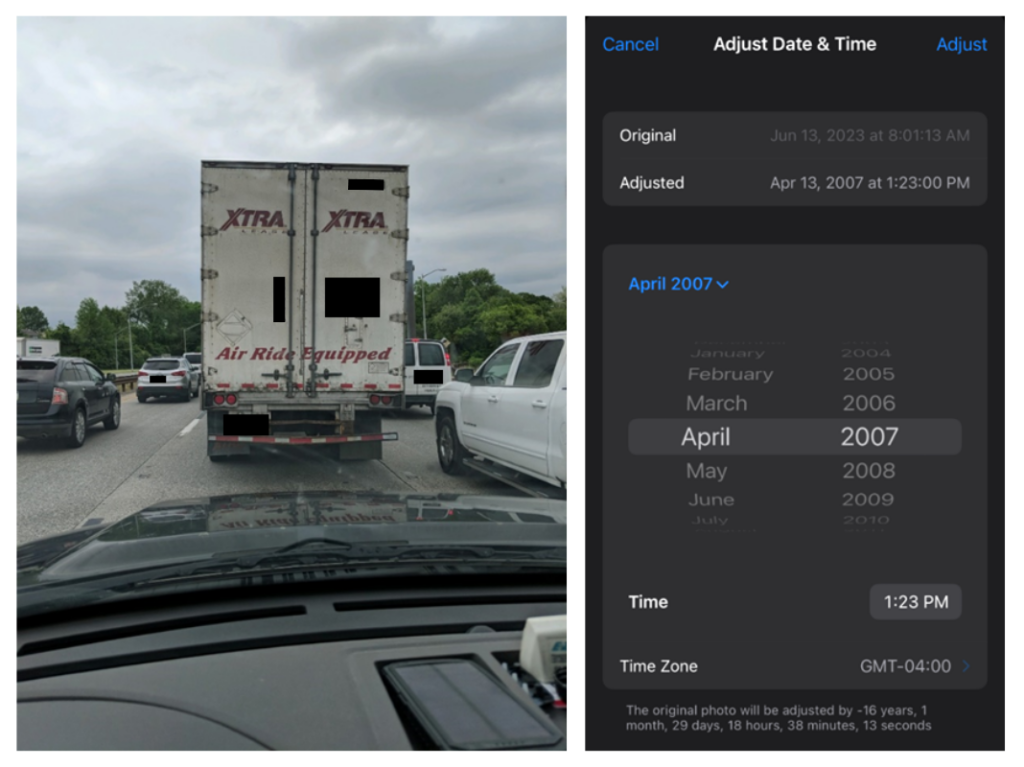Investigating Heavy Vehicle Hit-and-Runs with Digital Forensics

Timothy R. Primrose, Mobile Forensic Analyst
Hit-and-run accidents involving heavy vehicles such as tractor-trailers, school buses, and trash trucks present a unique set of challenges in relation to validating evidence, verifying incident timelines, and corroborating testimonies. For example, claimants often provide a photo of an alleged incident along with a screenshot showing a timestamp to further corroborate their account. These timestamps, however, are easily manipulated using native photo applications on mobile devices like smartphones or through other software, complicating the process to authenticate the images as digital media evidence. To illustrate this concept, the image below includes a photo of a tractor-trailer taken on an iPhone and a screenshot from the device’s native photo application to show how easily timestamps can be adjusted.

Authenticating Digital Media Evidence Through Forensic Analysis
A forensic download of the device that originally captured a photo or screenshot is essential to verify the image’s authenticity and rule out alterations. Metadata extracted through a device download can provide critical information such as the actual date and time the photo was taken, the device used, and the location (see example below). Analyzing digital media evidence with this level of scrutiny early in an investigation is paramount to establish whether the evidence is credible.
Leveraging Dashcam and Fleet Management Technology
If a claimant’s photo does not capture the other vehicle’s license plate number or other identifying features, dashcams or fleet management systems may assist efforts to verify the location of the vehicle allegedly involved in the hit-and-run.
Many heavy vehicles in operation nowadays are equipped with dashcams and/or integrated with fleet management systems. While dashcam footage may not always capture the actual incident, visual context clues like traffic and road signs, buildings, or even natural landscape features can help to determine the vehicle’s location around the time of the alleged hit-and-run.
Fleet management systems maintain detailed logs of the vehicle’s whereabouts with timestamped latitude and longitude coordinates. By obtaining access to a fleet management system online or via the necessary software, forensic analysts can review the location records of all fleet vehicles in the vicinity of the alleged incident at the time to compare with the claimant’s account.
These records may reveal that a heavy vehicle was in the general area of the alleged incident but traveling in the opposite direction or on a different side of a highway divider. In other circumstances, an absence of heavy vehicles in the area around the time of an alleged incident suggests the possibility of accident fraud. This information can be pivotal in disproving the claimant’s account by demonstrating the impossibility of the incident occurring as described.
The image below illustrates an obvious discrepancy in the location of a tractor-trailer supposedly at fault in a hit-and-run collision involving the claimant’s passenger vehicle. Location data from the regional carrier’s fleet management system established that their closest tractor-trailer in operation at the time of the alleged incident was approximately 65 miles away.

Shifting Gears from Digital Forensics to Collision Reconstruction
If a heavy vehicle is confirmed to have been in the vicinity of an alleged hit-and-run, scrutinous review of available dashcam footage may enable investigators to identify additional evidence that is visible in the video. When the vehicles allegedly involved are accessible, physical inspections are completed to capture measurements of vehicle dimensions and document damages potentially consistent with the hit-and-run theory, such as paint transfer matching the claimant’s vehicle.
Once investigators have obtained and verified sufficient information to support allegations of a heavy vehicle hit-and-run, the acquired data can be utilized by collision reconstruction engineers to perform a more comprehensive analysis. Collision reconstruction engineers seek to determine whether the incident could have realistically occurred in the manner described based primarily on the physical evidence. Digital media evidence and fleet management records are then considered in combination with the engineering analysis to help establish a credible sequence of events.
Hit-and-run claims involving heavy vehicles often require a multifaceted approach to piece together a full, fact-based understanding of the incident dynamics, especially in today’s era where digital manipulation of evidence is increasingly sophisticated and widespread. In summary, digital forensic techniques can help address the unique challenges presented in these investigations by acquiring, analyzing, and authenticating digital media evidence from devices such as cell phones, dashcams, and fleet management systems.
Categories: Digital Forensics | Education | Mobile Forensic Analyst | Timothy R. PrimroseTags: Cell Phone Downloads | Dashcam | Digital Evidence | DME | Fleet Management | Heavy Vehicle | Hit-and-Run | Physical Evidence | Tractor-Trailer


